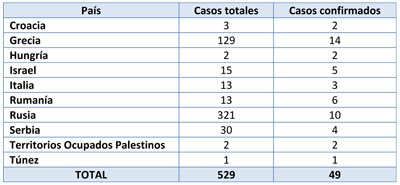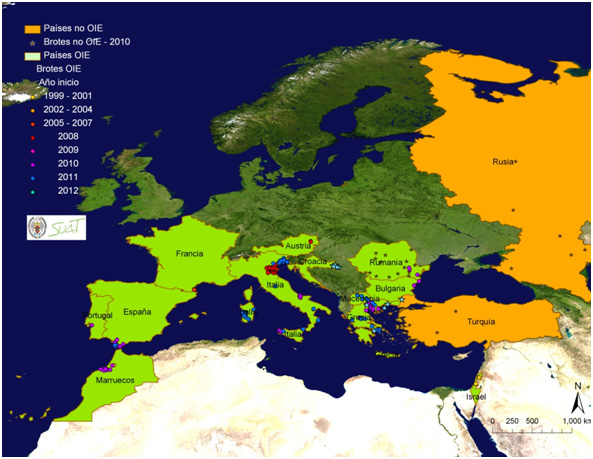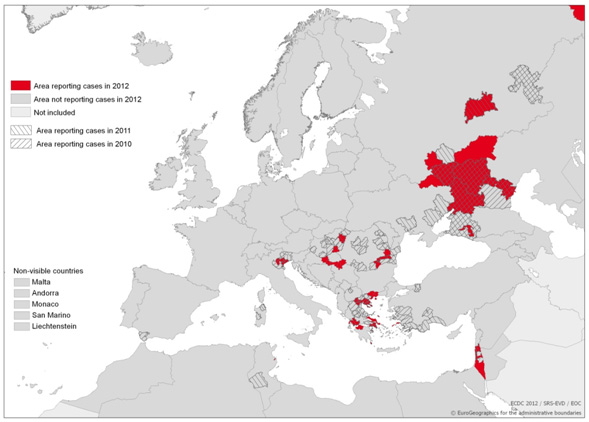West Nile in Europe
Víctor Rodríguez Prieto & José Manuel Sánchez-Vizcaíno
September 17th, 2012. SUAT-UCM
Situation of West Nile in european environment in 2012.
In the European Union West Nile (WN) cases have only been reported during 2012 in equine in Greece and Croatia (Figure 1). Greece began suffering the disease in horses in 2010. Since then, at least 59 horses have been affected by the WN virus infection. As for Croatia, this is the first time that WN outbreaks are reported, having affected six horses. This is not surprisingly, given the active movement that the virus is having in recent years in the area (Figure 1). Although official data is not available yet, it is likely that lineage 2 is the responsible for the outbreaks in both countries.
Fig. 1. West Nile outbreaks in horses in Europe and the Mediterranean from 1999 to 2012.
The blue stars show the outbreaks reported during 2012 in Croatia and Greece
(Source: self elaboration with data from WAHID-OIE; last update September 17th, 2012).
This lineage is originally from southern Africa, but since its coming to Hungary in 2004, it is causing major outbreaks in Eastern Europe both in animals (birds and horses) and humans (Figures 1 and 2). In fact, although the lineage cannot be confirmed in the majority of them, more than 500 cases of human disease have been described in 2012 so far (Table 1), mostly associated with the elderly and immunocompromised people. However, it appears that the virulence is higher than described in previous years.
Fig. 2. Reported cases of West Nile in humans in Europe in 2012 compared with 2010 and 2011
(Source: ECDC; last update September 14th, 2012).
Table 1. Number of West Nile cases in humans in Europe in 2012 (Source: ECDC; last update September 14th, 2012) (Criteria for considering a case as confirmed).

Historically, it was believed that lineage 2 was less virulent than lineage 1a, which has been circulating in Europe much longer and is considered responsible for the outbreaks in Western European countries, Spain included. However, recent studies have shown that both lineages can cause both mild and serious neuroinvasive cases (De Filette et al., 2012). Furthermore, there is evidence that both lineages are circulating in the Mediterranean basin simultaneously, even coinciding in the same areas (Savini et al., 2012) and that the timing of the appearance of the first outbreaks of the season is anticipating (July) (Barzon et al., 2012) compared to other years.
At present, the season for WN virus transmission is still open in the European Union. Thus, the situation with both lineages in horses and birds has to be monitored, both in affected and neighbouring countries. The peculiarities of recent outbreaks and the creation of new epidemiological scenarios suggest a change in the pattern of WN occurrence. Furthermore, although there is evidence that vaccine against one lineage also protects against the other (see e.g. McDonald et al., 2007, Martina et al., 2008) in vivostudies in horses with strains that are currently circulating would be recommended.
References:
Barzon L, Pacenti M, Franchin E, Lavezzo E, Martello T, Squarzon L, Toppo S, Fiorin F, Marchiori G, Russo F, Cattai M, Cusinato R, Palù G (2012). New endemic West Nile virus lineage 1a in northern Italy, July 2012. Euro Surveillance 17(31):pii=20231.
De Filette M, Ulbert S, Diamond M, Sanders NN (2012). Recent progress in West Nile virus diagnosis and vaccination. Veterinary Research 43:16.
European Centre of Disease Prevention and Control (ECDC), 2012. West Nile fever maps (acceso 17 de septiembre de 2012).
Martina BE, Koraka P, van den Doel P, van Amerongen G, Rimmelzwaan GF, Osterhaus AD (2008). Immunization with West Nile virus envelope domain III protects mice against lethal infection with homologous and heterologous virus. Vaccine 26, 153-157.
McDonald WF, Huleatt JW, Foellmer HG, Hewitt D, Tang J, Desai P, Price A, Jacobs A, Takahashi VN, Huang Y, Nakaar V, Alexopoulou L, Fikrig E, Powell TJ (2007). A West Nile virus recombinant protein vaccine that coactivates innate and adaptive immunity. Journal of Infectious Diseases 195, 1607-1617.
Organización Mundial de Sanidad Animal (2012). Interfaz de la base de datos del sistema mundial de información zoosanitaria (WAHID) (acceso 17 de septiembre de 2012).
Savini G, Capelli G, Monaco F, Polci A, Russo F, Di Gennaro A, Marini V, Teodori L, Montarse F, Pinoni C, Pisciella M, Terregino C, Marangon S, Capua I, Lelli R (2012). Evidence of West Nile virus lineage 2 circulation in Northern Italy. Veterinary Microbiology 158, 267-273.




